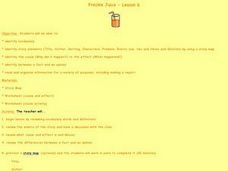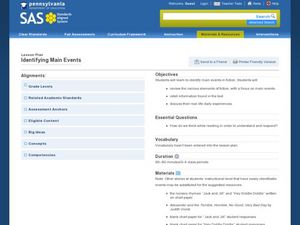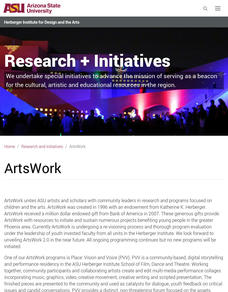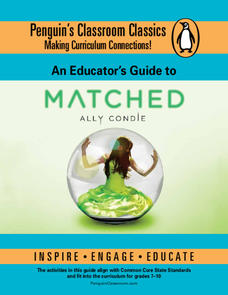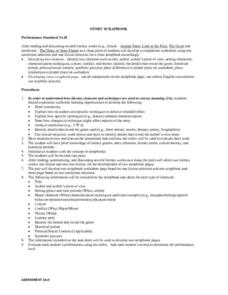Curated OER
"Esio Trot" by Roald Dahl
Students read Roald Dahl's Esio Trot and complete vocabulary and reading activities. In this reading and vocabulary lesson, students review vocabulary for the activity and listen to the story. Students discuss the story elements and...
Curated OER
"Thank You Ma'am" by Langston Hughes
Students use Langston Hughes' "Thank You Ma'am" as a reading and vocabulary improvement activity. In this reading and vocabulary lesson, students review the related vocabulary and read the poem. Students discuss the story elements in the...
Curated OER
Lesson Plan 1: Introducing NaNo and Novels
Did you know that November is Novel Writing Month? In the first of a series of lessons, class members are introduced to the NaNoWriMo (National Novel Writing Month) project.
Curated OER
Story Writing
Second graders review the basic elements of a story. Individually, they write their own original story as they use a software program to help them map out their ideas. With a partner, they exchange papers and read them for grammatical...
Curated OER
Arthur Meets the President
Students discuss the role of the President. In this government lesson, students read Arthur Meets the President and complete a story map. Students develop new vocabulary related to the story.
Curated OER
Freckle Juice- Lesson 6
Students read Freckle Juice. In this comprehension instructional activity, students complete a story map and discuss cause and effect based on readings from Freckle Juice.
Curated OER
Moby Dick Puppetry
Such an ambitious lesson! Third graders with special needs listen to an audio recording of the novel, Moby Dick. They stop often to discuss each of the main characters and analyze their actions in the story. They then make puppets of one...
Curated OER
Great Expectations: Group Writing
Examine the differences between totalitarianism and democracy in this writing lesson. Using the same format and theme from Great Expectations, young writers work in pairs to compose their own short stories. They follow guidelines for the...
Curated OER
Identifying Main Events
Help kindergartners learn to identify the main events in fiction. They will review elements of fiction, retell information found in the text, and discuss their real-life daily experiences. All the while, they will be asking themselves...
Curated OER
Yellow Bird and Me
Upper elementary artists create works which demonstrate an understanding of the many elements of theater and the visual arts. This four-day plan combines many wonderful aspects of visual, musical, and theatrical arts into one very...
Curated OER
Bambara's The Lesson
Twelfth graders read the short story The Lesson. They research the socio-economic and cultural context of the story and author. They examine the author's point of view. They analyze the first person narration in the story. They rewrite...
Curated OER
Special Sunflowers
Students view a picture of Van Gogh's Sunflowers. In this caring and kindness lesson students read Camille and the Sunflower and explore the feelings of the characters. Students complete worksheets related to Camille's feelings in the book.
Curated OER
Rural Life During the Great Depression: A Year Down Yonder
“Anyone who thinks small towns are friendlier than big cities lives in a big city.” Mary Alice, the fifteen-year-old narrator of A Year Down Yonder, is forced to leave Chicago and spend a year with her Grandma Dowdel in a small rural...
Prestwick House
Rhyme and Repetition in Poe's "Annabel Lee"
Many and many a year ago Edgar Allan Poe crafted the chilling tale of "Annabel Lee." The poem is the perfect vehicle to introduce Poe's concept of unity of effect, the idea that every element in a poem or story should help to develop a...
Curated OER
Through the Eyes of the Big Bad Wolf
Imagine how the wolf would tell the tale of Little Red Riding Hood or The Three Little Pigs. Young writers re-imagine classic tales by adopting the point of view of another character in the story. After reading models like The True Story...
Curated OER
Analyzing Literary Devices
Eighth graders identify figurative language and poetry in this literary analysis lesson. Using Through the Looking Glass by Lewis Carroll and a YouTube video for "The Walrus and the Carpenter," young readers complete a literary device...
Curated OER
Folktale Writing
Review literary analysis techniques with this reading lesson about folktale writing. Middle schoolers read different folktales from many authors, and write their own folktales to share with the class. They identify the plot, morals and...
DeKalb County Schools
Compare/Contrast
A series of reading activities is sure to engage your young readers! Based on comparing and contrasting ideas, the packet provides opportunities to compare characters, themes, texts, and other elements of fiction.
Museum of Tolerance
Immigration Journeys
Through the journey of four stories of immigration, scholars complete graphic organizers and apply knowledge to create a visual representation of their findings on a large poster. Third and fourth readers write a letter to their...
Penguin Books
An Educator's Guide to Matched by Ally Condie
Even supposed Utopian societies have their flaws. Using an educator's guide, individuals explore the society Ally Condie creates in Matched. Reflective writing prompts double as discussion questions and cover key themes in the novel, as...
Curated OER
Crossroads Cafe: "Who's the Boss?" Act 1
Students pronounce key phrases during a story. They discuss the story setting and the roles of the characters. They explain the problems the main characters face.
Curated OER
Story Scrapbook
Pupils develop a comparison worksheet using one non fiction book and one fiction book they have read to be put into a class scrapbook. In their comparison students must have title, author, point of view, setting, characters, and other...
Curated OER
Comprehension: Setting
Young scholars discuss what setting represents. In this language arts lesson plan, students review the three elements of setting: where the story takes place, when does the story take place, and is it past, present, or future? Young...
Curated OER
The Time I Got Lost
Third graders go through the writing process but substitute paper and pencil with the computer to create a story about "The Time I Got Lost".





